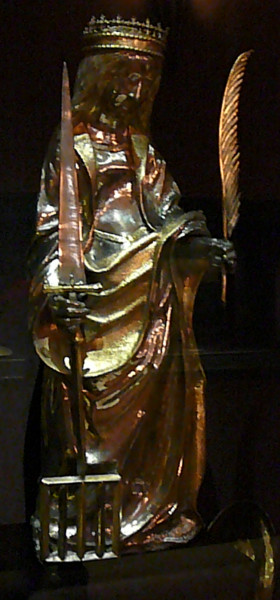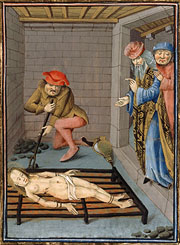The other Christians had gone into hiding under a rock shelter just outside the city. But they could see what was happening to Foy, and their leader Caprasius had a vision while praying for her. He saw a dove descend from Heaven with a jeweled crown that it placed on the young girl's head.
This vision inspired Caprasius to go forth from hiding and declare his faith before the judge. Dacian again tried to persuade him to save his life by recanting, but when he refused Dacian had the attendants "rend his flesh without pity" (ibid., 36). His constancy inspired two onlookers, Primus and Felicianus, to convert. Finally, since neither they nor Foy nor Caprasius would yield, Dacian had them all beheaded.
This story provides four attributes that can be used in images of St. Foy: a gridiron, a dove, a crown, and a sword. (Plus, of course, the palm branch signifying martyrdom.) The statuette at right has all of these except the dove. This modern window has just the dove and the crown.
Prepared in 2013 by Richard Stracke, Emeritus Professor of English, Augusta University

Statuette in the church treasury, Conques (See the description page)

The Martyrdom of St. Foy
Source: Wikimedia Commons
ATTRIBUTES
- Gridiron
- Dove
- Crown
- Sword
MORE IMAGES
- 12th century: St. Foy in the west tympanum at Conques.
- Undated, probably post-medieval: A statue in the village of St. Marcel, not far from Conques.
DATES
- Foy's death is variously reported as occurring in 287 or 303 (at age 12, according to the "Song of Sainte Foy").
- Feast of St. Foy: October 6.
- Feast of SS. Caprasius, Primus, and Felicianus: October 20 (even though the texts all attest that they were martyred the same day as Foy – see Acta Sanctorum, October vol. 8, 823).
NAMES
- In French, Sainte Foy or Sainte Foi
- In the U.K., St Faith
- In Spanish, Santa Fe
- In Latin texts, Sancta Fides
BIOGRAPHY
- Sheingorn has English translations of what she entitles "The Passion of Sainte Foy," "The Song of Sainte Foy," and the Book of Miracles of St. Foy by Bernard of Angers.
- Bokenham, "The Lyf of Seynt Feyth" in Legends of Holy Women (91-102 in Kölbing, 71-79 in Delany).
- "Seint Fides" in the Early South English Legendary (85-86).
- The Acta Sanctorum's October volume 8 addresses Caprasius's feast day on October 20 and has a prose "Passion of SS. Foy, Caprasius, Primus, and Felicianus" at (823-26) and a "Metrical Passion of SS. Foy and Caprasius" (826-29).
- October volume 3 has a full section on "St. Foy, Virgin Martyr, and Martyr Companions" (263-329) with hymns, poems, an Acta Sanctae Fidis, and the Bernard of Angers's Miracles.
ALSO SEE